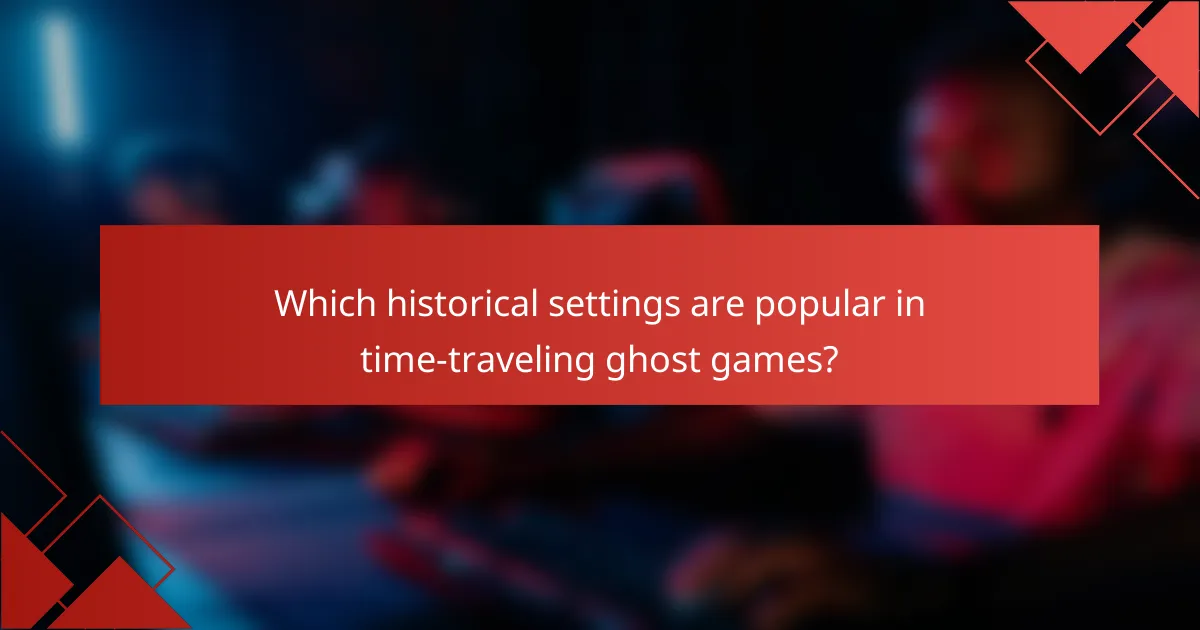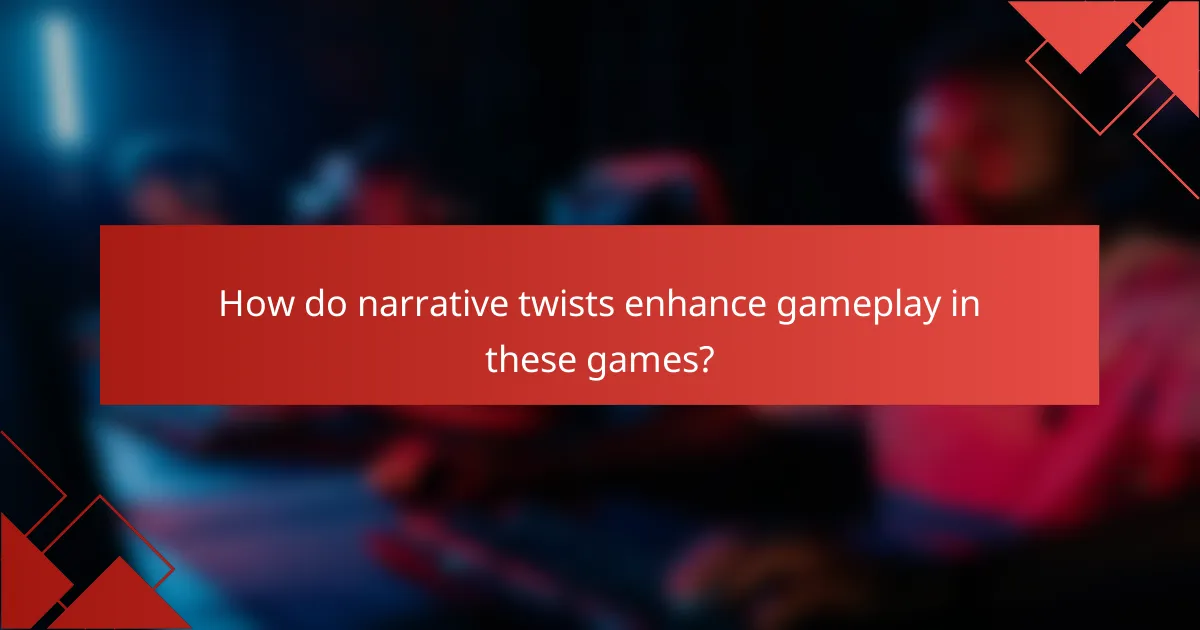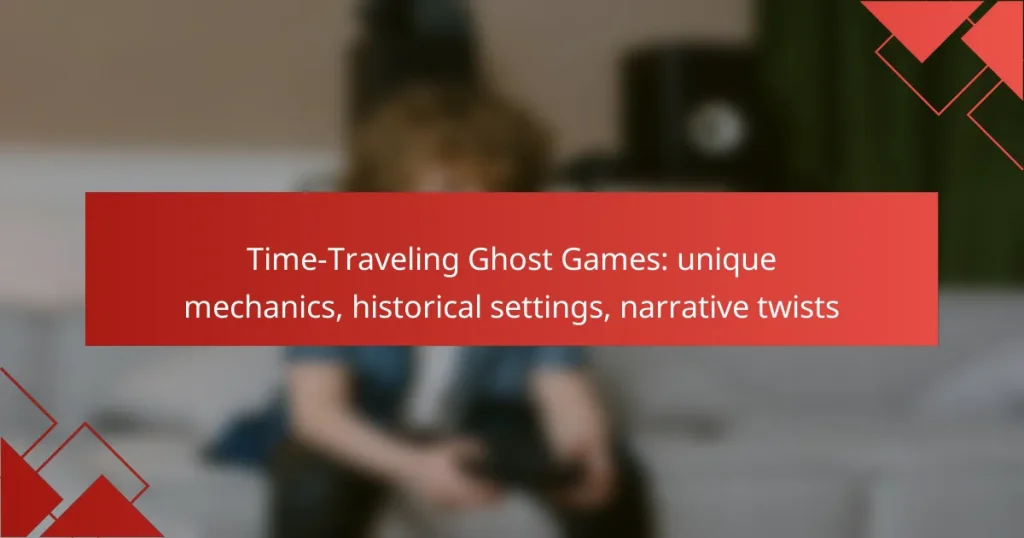Time-traveling ghost games uniquely combine supernatural elements with the thrill of temporal exploration, allowing players to traverse various historical periods. As they solve puzzles and interact with spirits, players influence narratives through their choices, all set against richly detailed backdrops like Victorian England and Ancient Rome. The incorporation of unexpected narrative twists further deepens the experience, challenging players to adapt their strategies and assumptions as they navigate this hauntingly immersive world.

What are the unique mechanics of time-traveling ghost games?
Time-traveling ghost games feature distinctive mechanics that blend supernatural elements with temporal exploration. Players navigate through different historical periods while solving puzzles, interacting with spirits, and influencing narratives based on their choices.
Temporal puzzles
Temporal puzzles are a core mechanic where players must manipulate time to solve challenges. These puzzles often require players to interact with objects or characters in one timeline to affect outcomes in another. For instance, fixing a broken artifact in the past might unlock a path in the present.
To effectively tackle temporal puzzles, players should pay attention to clues scattered throughout the game. Keeping track of time-related events and their consequences can help in devising strategies to progress.
Ghost interaction systems
Ghost interaction systems allow players to communicate and collaborate with spirits from various eras. These interactions can reveal vital information, unlock quests, or provide unique abilities that aid in gameplay. For example, a ghost might share secrets about a historical event that can change the player’s approach.
Understanding each ghost’s background and motivations is crucial. Players should engage with spirits thoughtfully, as some may have specific requirements or conditions for assistance.
Dynamic narrative branching
Dynamic narrative branching enables players to influence the storyline based on their choices and interactions. Decisions made in one time period can ripple through others, altering character fates and plot outcomes. This mechanic encourages replayability, as players can explore different narrative paths.
To maximize the impact of choices, players should consider the long-term consequences of their actions. Keeping a mental note of key decisions can help in navigating complex storylines effectively.
Multi-era gameplay
Multi-era gameplay immerses players in diverse historical settings, each with unique challenges and aesthetics. Players can switch between different time periods, experiencing distinct cultures and events. This mechanic enriches the gameplay by offering varied environments and storylines.
When engaging in multi-era gameplay, players should familiarize themselves with the historical context of each period. This knowledge can enhance interactions with characters and improve puzzle-solving strategies.
Environmental manipulation
Environmental manipulation allows players to alter their surroundings to solve puzzles or reveal hidden paths. This can include moving objects, changing the state of the environment, or even affecting the weather. For example, flooding a room in the past might uncover a hidden chamber in the present.
Players should experiment with different environmental elements, as some may yield unexpected results. Observing how changes affect the game world can lead to innovative solutions and discoveries.

Which historical settings are popular in time-traveling ghost games?
Time-traveling ghost games often feature historical settings that enhance the eerie atmosphere and narrative depth. Popular locales include Victorian England, Ancient Rome, Medieval Japan, the Roaring Twenties, and the Cold War era, each offering unique mechanics and storytelling opportunities.
Victorian England
Victorian England is a favored setting due to its rich history and gothic elements. Players can explore haunted mansions, foggy streets, and the social dynamics of the time, often encountering spirits tied to the era’s strict moral codes and class struggles.
Key mechanics in this setting might involve solving mysteries related to famous figures or events, such as Jack the Ripper or the Industrial Revolution. Players should pay attention to the cultural context, which can influence ghostly encounters and puzzles.
Ancient Rome
Ancient Rome offers a backdrop of grandeur and intrigue, with its temples, forums, and gladiatorial arenas. Ghost games set in this era often incorporate historical figures and events, allowing players to interact with the spirits of emperors or soldiers.
Mechanics may include navigating political conspiracies or uncovering secrets of the Roman Empire. Players should be aware of the significance of Roman mythology, as it often plays a role in the narrative and ghostly interactions.
Medieval Japan
Medieval Japan, with its samurai culture and spiritual beliefs, provides a unique setting for ghost games. Players can explore ancient villages, temples, and battlefields, encountering yūrei (ghosts) that reflect the period’s folklore and traditions.
Game mechanics may involve rituals to appease spirits or combatting malevolent entities. Understanding the cultural significance of honor and duty in this era can enhance gameplay and narrative engagement.
Roaring Twenties
The Roaring Twenties is characterized by its vibrant social scene and post-war optimism, making it an intriguing setting for ghost games. Players can navigate jazz clubs, speakeasies, and lavish parties, often encountering spirits from the Prohibition era.
Mechanics might focus on solving crimes or uncovering secrets related to the era’s cultural icons. The contrast between the lively atmosphere and ghostly encounters can create compelling narrative twists.
Cold War era
The Cold War era, marked by tension and espionage, offers a unique backdrop for ghost games. Players can explore abandoned military bases, secretive government facilities, and urban landscapes, encountering spirits linked to the fears and conflicts of the time.
Game mechanics may involve espionage tactics and uncovering hidden truths about historical events. Players should consider the political climate, as it can influence ghostly interactions and the overall narrative experience.

How do narrative twists enhance gameplay in these games?
Narrative twists significantly enhance gameplay in time-traveling ghost games by introducing unexpected elements that challenge players’ assumptions and decisions. These twists create a dynamic storytelling environment where players must adapt their strategies based on new information and shifting circumstances.
Unexpected character revelations
Unexpected character revelations can dramatically alter the player’s perception of the story and its characters. For instance, a seemingly benign ghost may reveal a dark past that influences the player’s choices and alliances. These twists not only deepen character development but also encourage players to reconsider their interactions and decisions throughout the game.
Players should pay close attention to dialogue and environmental clues, as these often foreshadow significant character twists. Engaging with side quests can also uncover hidden backstories that enrich the main narrative.
Shifting alliances
Shifting alliances are a common feature in time-traveling ghost games, where characters may change their loyalties based on new information or player actions. This mechanic keeps players on their toes, as they must navigate a landscape of trust and betrayal. For example, a ghost who initially assists the player may later become an antagonist if the player makes certain choices.
To manage shifting alliances effectively, players should remain flexible in their strategies and be prepared to reassess their relationships with characters frequently. Building rapport with multiple characters can provide backup options if alliances shift unexpectedly.
Alternate timelines
Alternate timelines introduce a layer of complexity by allowing players to explore different outcomes based on their decisions. In these games, players can often revisit key moments to alter events, leading to various narrative paths. This mechanic not only enhances replayability but also allows for exploration of “what if” scenarios that can change the overall story arc.
Players should experiment with different choices in alternate timelines to fully experience the breadth of the narrative. Keeping track of decisions and their consequences can help in understanding how timelines diverge and converge.
Player-driven outcomes
Player-driven outcomes empower gamers to shape the story based on their choices, leading to multiple endings and varied experiences. This mechanic emphasizes the importance of player agency, as decisions made throughout the game can lead to dramatically different resolutions. For example, saving a character might lead to a happy ending, while neglecting them could result in tragedy.
To maximize the impact of player-driven outcomes, players should consider the long-term effects of their decisions rather than focusing solely on immediate rewards. Engaging with all aspects of the game, including dialogue options and side quests, can reveal how choices resonate throughout the narrative.

What are the criteria for selecting a time-traveling ghost game?
When selecting a time-traveling ghost game, consider gameplay mechanics, story depth, and visual style. These elements significantly influence the overall experience and immersion in the game.
Gameplay mechanics
Gameplay mechanics in time-traveling ghost games often involve puzzle-solving, exploration, and interaction with historical figures or events. Players may need to manipulate time to solve challenges, such as altering past actions to affect the present. Look for games that offer a balance between action and strategy to keep the experience engaging.
Consider mechanics like time loops, where players must repeat actions to uncover clues, or ghostly abilities that allow for unique interactions with the environment. Games that incorporate these features tend to provide a richer experience.
Story depth
The narrative in time-traveling ghost games should be compelling and layered, often intertwining personal stories with larger historical events. A well-developed plot can enhance player engagement, making them feel invested in the characters and their journeys through time.
Look for games that offer multiple endings or branching storylines, as these can provide replayability and encourage exploration of different outcomes. Strong character development and emotional stakes are essential for a memorable narrative experience.
Visual style
Visual style plays a crucial role in creating the atmosphere of a time-traveling ghost game. Art direction can range from realistic depictions of historical settings to stylized graphics that enhance the supernatural elements. Choose games that match your aesthetic preferences while effectively conveying the game’s themes.
Pay attention to how visual elements support storytelling, such as using color palettes to evoke emotions or design choices that reflect the time period. A cohesive visual style can significantly enhance immersion and enjoyment.


